- Aga Khan Road, NSSF Building
- safari@tanzaniapurenatureandtravel.com
- 10+ Years Of Experience
9 Days Kilimanjaro Climb Northern Circuit Route

5 Star Rated
Best Local Tour Operator

Best Local Tour Operator
9 Days
Mt. Kilimanjaro
Kilimanjaro Int. Airport
$ 3,210/ Person
The Northern Circuit is the newest and longest route on Mount Kilimanjaro. It begins in the West at the Londorossi Gate and follows the same path as the Lemosho route for the first two days. After crossing the Shira plateau the path veers north near Lava Tower, following the longer Northern Circuit instead of the more popular Southern Circuit via Barranco Valley The route circles around the quieter northern slopes to the east side of the mountain. The Northern Circuit is longer than the other trails on Kilimanjaro, taking a minimum of eight or nine days to complete. The eight-day trek skips the additional acclimatization day that is usually spent at Shira Camp 2 and continues straight on to Moir Camp.
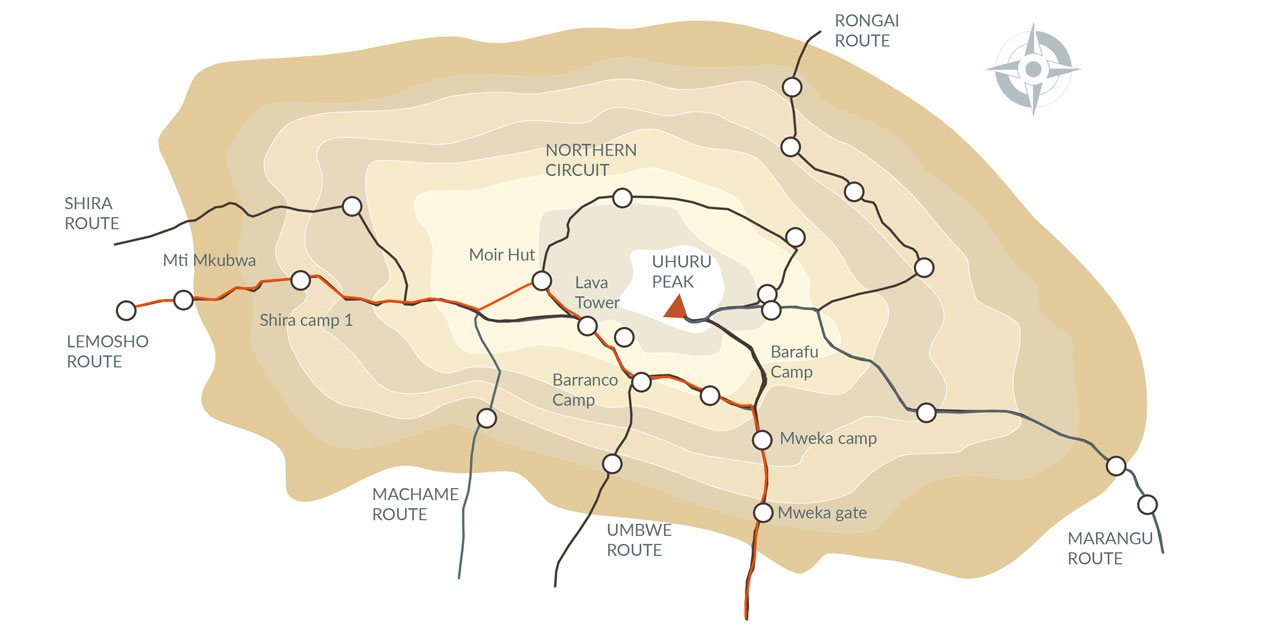
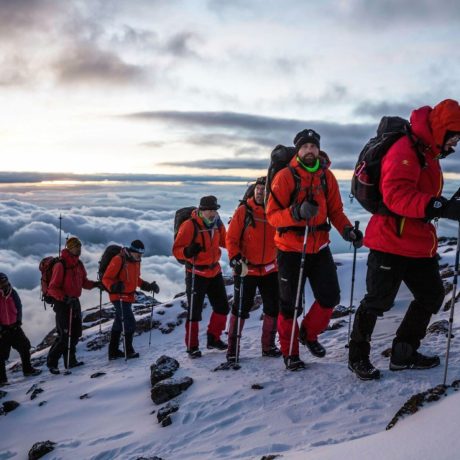
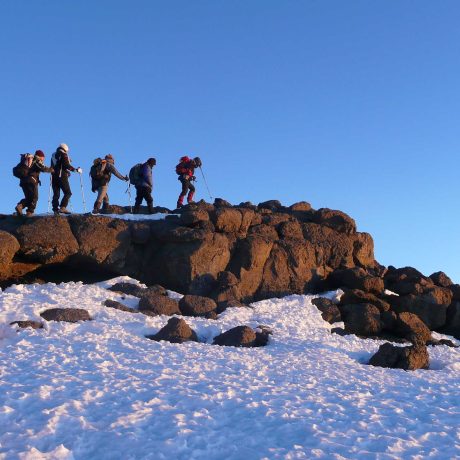
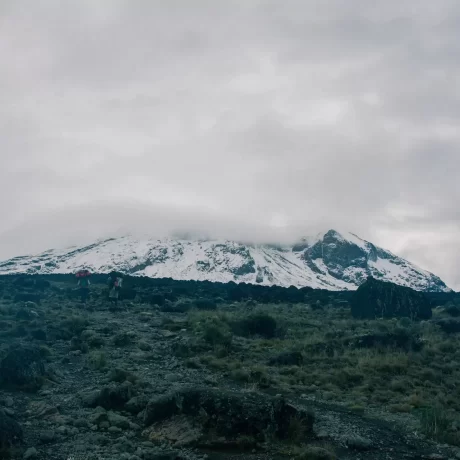
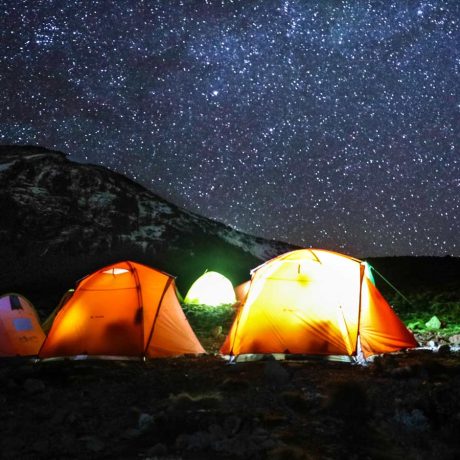
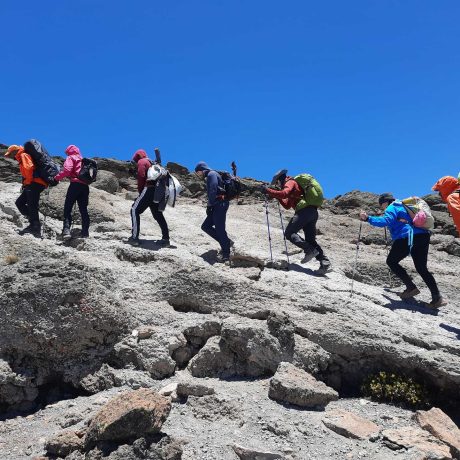
You will be picked up at the Kilimanjaro International Airport and transferred to your hotel in Moshi town; you will meet your guide who will brief you on your upcoming trek and do an equipment check to make sure you have all the necessary mountain gear. The missing gear can be rented on this day.
Meals: Breakfast, Lunch & Dinner Included
The Northern Circuit Route begins at Londorossi Gate (2,100 meters) in the West, the same start point as the Lemosho Route. The drive to Londorossi Gate takes approximately two hours from Moshi and considerably longer from Arusha. Registration with the Kilimanjaro National Park authorities occurs at the gate and then you will be driven further up the mountain to the trailhead starting point. Most tour operators serve lunch here before the short first day trek to Mti Mkubwa Camp (2,820 meters) begins. You may get lucky and spot large wildlife like elephant and buffalo that sometimes emerge from the rainforest onto the path as you trek towards your first camp. Dinner will be served when you reach Mti Mkubwa Camp.
Distance: ~5.5km / 3 miles
Trekking time: 3-4 hours
Zone: Rainforest
Meals: Breakfast, Lunch & Dinner Included
The Northern Circuit Route begins at Londorossi Gate (2,100 meters) in the West, the same start point as the Lemosho Route. The drive to Londorossi Gate takes approximately two hours from Moshi and considerably longer from Arusha. Registration with the Kilimanjaro National Park authorities occurs at the gate and then you will be driven further up the mountain to the trailhead starting point. Most tour operators serve lunch here before the short first day trek to Mti Mkubwa Camp (2,820 meters) begins. You may get lucky and spot large wildlife like elephant and buffalo that sometimes emerge from the rainforest onto the path as you trek towards your first camp. Dinner will be served when you reach Mti Mkubwa Camp.
Distance: ~5.5km / 3 miles
Trekking time: 3-4 hours
Zone: Rainforest
Meals: Breakfast, Lunch & Dinner Included
On day three the trek crosses the Shira Plateau from Shira Camp 1 to Shira Camp 2. Nine day trekkers usually spend the night at Shira Camp 2 where they will join trekkers from the Machame Route. At Shira Camp 2 it is worth trekking a little higher up the plateau to enjoy the stunning view across the valley below and Western Breach of Kilimanjaro above. The plateau is exposed so be prepared for a cold night with temperatures getting below zero. Note: Trekkers on an eight day hike will continue east up the Shira Plateau ridge and on to Lava Tower (4,600 meters) and then back down via the Northern Circuit to Moir Camp (4,200 meters).
Distance: ~7km / 4 miles
Trekking time: 3-4 hours
Zone: Rainforest / Low Alpine Zone
Meals: Breakfast, Lunch & Dinner Included
Day four is a long trek heading east which passes through the ‘Garden of the Senecios’ and then enters the high alpine desert zone. The morning is spent trekking up to Lava Tower and the iconic Shark’s Tooth rock formation at 4,600 meters, where you will have lunch. After lunch you will join the northern circuit heading down to Moir Camp at 4,200 meters (see map above). This is an important day in your trek as you will get to experience high altitude and then sleep low, which is good for the acclimatization process.
Distance: ~14km / 8 miles
Trekking time: 5-7 hours
Zone: Low alpine zone / High alpine zone
Meals: Breakfast, Lunch & Dinner Included
Day five involves a moderately steep climb out of Moir Valley. Trekkers can take a small detour here to climb the summit of Little Lent Hill at 4,375 meters before returning to the Northern Circuit trail. From here the route follows a series of inclines and declines, skirting around the northern slopes of Kibo to Buffalo Camp (4,020 meters).The trek gives great vistas out across the plains that lie north of Kilimanjaro and stretch out to the Kenyan / Tanzanian border. You will arrive at Buffalo Camp just after midday, where you will have lunch and have time to rest after a long day hiking.
Distance: ~12km / 7 miles
Trekking time: 5-7 hours
Zone: High alpine zone
Meals: Breakfast, Lunch & Dinner Included
Day six starts with a climb up the Buffalo ridge and down into Porfu Camp where lunch is usually served. The route then continues east around the northern slopes to the Rongai Third Cave at 3,800 meters. The trek is shorter than the day before and by now you should be feeling well acclimatised to the altitude. You will arrive at the Third Cave just around mid-afternoon.
Distance: ~8km / 5 miles
Trekking time: 5-7 hours
Zone: High alpine zone and low alpine zone
Meals: Breakfast, Lunch & Dinner Included
Day seven involves a steady incline up and over the Saddle which sits between the peaks of Kibo and Mawenzi Peak. Trekkers then continue walking south-west up to School Hut (4,800 meters). After arriving at School Hut you will be served an early dinner and then you should get some shut-eye as you will be awoken before midnight to start your summit attempt. Remember to prepare all your gear, including warm clothes, insulated water bottles, snacks, headlamp and camera before going to bed.
Distance: ~15km / 8 miles
Trekking time: 4-5 hours
Zone: High alpine zone and glacial zone
Meals: Breakfast, Lunch & Dinner Included
You will be awoken around 11:30 with hot tea and biscuits and will then begin the steep incline up the slopes of Kibo under the cover of darkness. Your first check-point is Hans Meyer Cave where you will take a short break. The climb steepens as you approach Gilman’s Point (5,681 meters), which will be around 5-6 hours after departing School Hut. Take a moment to enjoy the approaching dawn and incredible view out and across to Mawenzi Peak, but remember you still have 2 hours trekking to reach Uhuru Peak so dig deep for the energy. The slope flattens as you head west around the crater rim and you should arrive at the summit at or just after sunrise. Your stay here will be brief so get as many pictures as you can of the incredible views and surrounding glaciers.
You will then retrace your steps back around the crater rim to Stella Point (5,739 meters) where you will turn south and head down the heavily screed slopes of Kibo to Barafu Camp (4,680 meters). Most trekkers take a short break here before continuing down to Millennium Camp (3,950 meters) for your final night on the mountain. In total you will be trekking for 14-16 hours on day eight so it is important to pace yourself, remain hydrated and keep your blood sugar levels up. Note: some tour operators return via Gilman’s Point to Horombo Hut using the Marangu Route.
Distance: ~6km / 3.5 miles ascent and 10.5km / 6 mile descent
Trekking time: 6-8 hours ascent and then 4-6 hour descent
Zone: Glacial zone and all preceding zones
Meals: Breakfast, Lunch & Dinner Included
The final day is a short hike through the dense montane rainforest from Millennium Camp (3,950 meters) to Mweka Gate (1,640 meters). At the gate you will need to sign-out with the authorities, who will also provide you with your official certificate – a green certificate for those who made it to Gilman’s Point and a gold certificate for those who reached Uhuru Peak. It is customary to give your guide and porter tips before being driven back to your hotel in Moshi.
Distance: ~10km / 6.5 miles
Trekking time: 3-4 hours
Zone: Rainforest zone
Meals: Breakfast, Lunch & Dinner Included
The day is left free to wind down after the trek before your flight home. Depending on flight times you could go and explore Moshi town and grab some souvenirs before heading to the airport.
*Safari, Zanzibar and other add-ons are available if you wish to continue exploring Tanzania.
Meals: Breakfast Included
Camping on Mount Kilimanjaro offers adventurers a unique immersion into the awe-inspiring landscape of Africa’s tallest mountain. As trekkers ascend through diverse ecosystems, from lush rainforests to alpine deserts, camping sites become sanctuaries amidst the rugged terrain. Beneath star-studded skies, tents are pitched on designated platforms, providing respite and a sense of camaraderie among fellow climbers.
Each evening, as the sun dips below the horizon, campfires flicker, illuminating tales of the day’s journey and anticipation for the challenges ahead. With each night spent under the vast canopy of Kilimanjaro, campers forge unforgettable memories amid nature’s grandeur, making the ascent not just a physical feat, but a deeply enriching adventure of the spirit.
You are expected to carry your own day pack, with only things which should be able to sustain you until you reach the next camp at the end of the day. You do not need to carry your personal backpack/ duffel pack – It will be carried by our porters.
No worries about that – this is a common concern. It is much better for your body if you proceed slowly and guides will permanently remind you about this (“pole-pole” – which means “slowly slowly”). By walking slowly, your body will much better acclimatize to high altitude. There is plenty of time allocated each day for the treks, even for those who like to go very slowly.
Some climbers may fall short of reaching the summit, but not at the expense of their overall experience. Even for those who never reached the top, the experience of the wonders of Kilimanjaro is very rewarding. If one or more members of the group decide they cannot continue, or if a guide deems it unsafe for an individual (or a group) to continue, they are escorted to the most convenient campsite or Hut. Our guides intimately know the network of shortcuts to escort climbers to safety, and they are trained to act quickly and calmly under any circumstance.
On the Marangu Route, there are simple basic Huts. The first 2 Huts sleep four people each and the last Hut is a dome-style with bunk beds. On all the other routes, you will sleep in 3 dome-style Tents, two people each. The Tents are modern and have an outer flysheet and large vestibules to keep equipment from the elements. They are set up, broken down, and carried- along with everything else- by our porters. There are public toilets set up at every campsite, but portable toilets are available upon request at the cost of $ 100 per group for the whole tour. Hot water is provided for each person every morning but No showers during the trek There will be dining tents with chairs and tables where all meals will be served. Before any meal, we will provide soap and hot water for washing your hands.
For each trek on the Mount a dedicated cook will be part of the logistical team. They are professional chefs and can prepare different kinds of dishes. Please see a sample page for Dietary Menu.
You shouldn’t worry- You are in safe hands. Our guides are professionally trained to handle all sorts of distress and respond quickly and accordingly. They all have Wilderness First Aid Responder qualification and they will all time bring you to safety. They will directly call for an emergency evacuation if the situation worsens.
Arrange your trip in advance – book this amazing tour now!
We have been receiving reviews from our served clients, and Tanzania Pure Nature And Travel is rated 5/5 by customers. This honor is given to us by customers because we always remain committed to all our customers to do whatever is needed by them to make their safari fully satisfied.
Our itinerary ideas can be as tailored as you’d like around your particular interests. These selected suggestions will give you some inspiration, but treat them just as a starting point because for your own trip will be created uniquely for you.
We targets the up market travelers, Budget and special interest groups such as students, the physically impaired (People with disabilities), corporate clients and the budget traveler (backpackers).




Copyright © 2025, All rights reserved to Tanzania Pure Nature and Travel | Crafted By Technoclick Tz